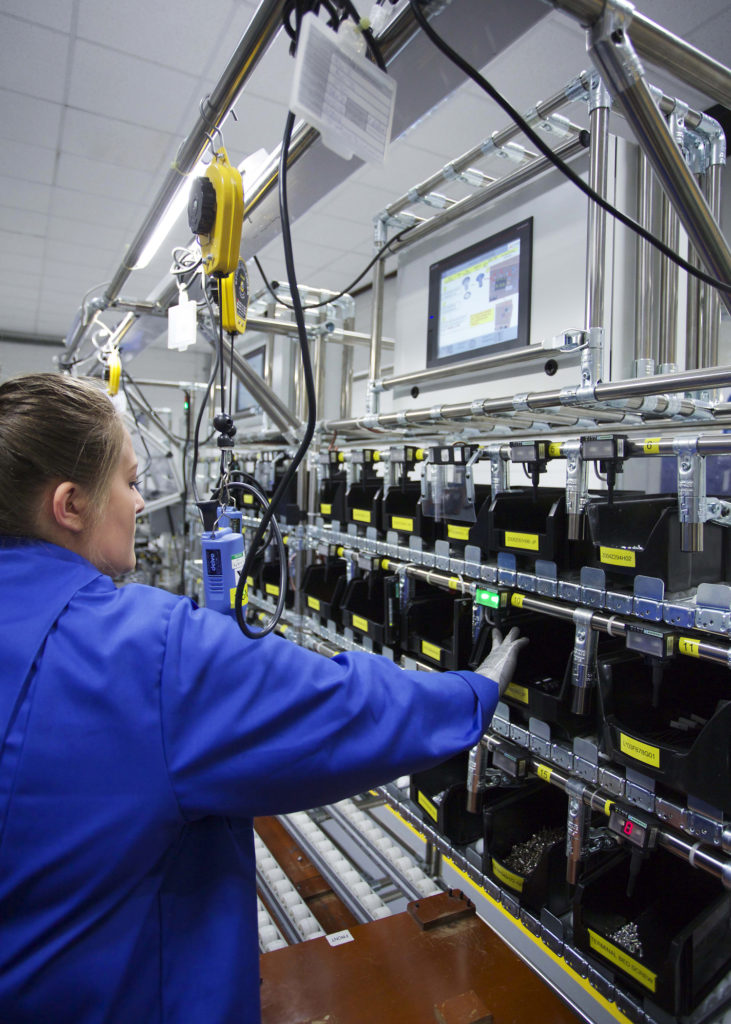Poka Yoke (the Japanese term for mistake-proofing) is used to describe pick-to-light systems for manual assembly work.
Mitsubishi Electric has moved the concept several steps forward to create Guided Operator Solutions (GOS) that essentially use a controller-based system of active assembly instructions and sequenced parts supply from bins to help operators perform picking and assembly tasks faultlessly every time.
An added advantage is that the system also allows these processes to be integrated fully into business Enterprise Resource Planning (ERP) and Manufacturing Execution Systems (MES), further enhancing the operational benefits and improvements they bring.
Quality by design
GOS allows production orders to be automatically allocated to a manufacturing or picking cell, which ensures the correct manufacturing schedule is delivered to the work area and a virtually instant changeover can be achieved, resulting in an extremely agile solution.
Manufacturing data can then be returned to the business systems so that accurate production information is available for OEE calculations, tracking and traceability.

This provides immediate and clearly visible benefits to assembly operators as well as entire production lines, as the solution minimises the occurrence and impact of errors in manufacturing and logistics operations, thereby improving efficiency and quality. This aims to eliminate slips at the source, before they can occur. The GOS applies the principle of error-proofing by guidance to aid assemblers picking the right part, at the right time.
In practice, GOS uses a controller that signals a station to indicate where the correct component to pick is located. By regulating signals or physical barriers on the appropriate parts bin, eg green and red lights (pick to light), sounds (pick to voice) or doors that automatically open and close, it becomes obvious to the operator which component to select.
As a result, the structure provided by GOS contributes to error-free part identification, localisation and delivery. Sequenced instructions can also be provided on-screen, using touch-screen HMIs for operator confirmation and interaction.
Anyone familiar with the training investment and impracticality of the piles of ring binders full of instructions required for traditional manual assembly cells will recognise what a revelation GOS systems can be for the operator and the production manager alike.
Manual assembly management fuelled by data
The presence of a modern, sophisticated controller on the manual assembly line provides unprecedented monitoring capabilities to plant managers that utilise ERP and MES systems.
These enterprise systems traditionally deliver visibility and actionable insight on machinery equipped with these controllers, allowing plants to run more efficiently and profitably.
An absence of highly capable automation solutions in manual assembly cells prior to using a GOS would traditionally exclude them from full real-time monitoring, control and optimisation.
The interconnectivity offered by GOS between manual assembly operations and higher-level enterprise systems enables the generation, distribution and analysis of relevant information that allows plant managers to monitor, understand and improve manual assembly processes.
In this way, industries do not need to replace human operators to embrace Smart Manufacturing principles.
By feeding data to the MES, GOS support the calculation of key performance indicators (KPIs) that quantify the performance of the assembly line and provide guidance on improvement strategies.
More precisely, fundamental parameters that can be assessed include overall equipment effectiveness (OEE), overall labour effectiveness (OLE), scrap/yield, right first time and re-work, on time in full (OTIF) delivery, rate of return and customer complaints.
Connecting GOS with MES and ERP systems
KPI metrics can therefore assist factories in improving the quality consistency of their products. As fewer defective assemblies reach the market, customers’ complaints, churn and product returns are minimised. This, in turn, can lead to substantial growth in both a company’s reputation and revenues.
On the production line, it is possible for plant managers to identify issues in operator performance and define OLE improvement strategies. Also, the amount of re-work and associated waste can be controlled. Therefore, it is possible to reduce them to a minimum whilst minimising the work in progress (WIP) between processes. In this way, the plant can improve its OEE.
In addition, the integration between a GOS, it’s PLC and an ERP system provides greater control over supply chain management processes.
By automatically providing access to the correct part bin data, GOS provides an insight into the number of components still available and when a given bin is reaching an empty state. Therefore, part replenishment can be based on real-time conditions, improving inventory management activities.
In addition, improved process understanding makes it possible to simplify scheduling operations and component allocation for multi- and mixed-model assemblies. Also, forecasting part requirements and end product demand becomes easier and more accurate, empowering industries to become leaner by balancing supply, inventory and demand.
As a result, just-in-time delivery and build-to-order strategies can be implemented, reducing over-production and costs related to stock storage of finished goods.
A holistic approach to flexible and efficient production
GOS was designed as a mistake-prevention by guidance strategy, able to improve productivity, product quality and flexibility on manual assembly lines.
The integration of GOS with higher-level enterprise systems further improves its potential impact on the entire production facility.
By turning manual assemblies into measurable entities, GOS allows assembly cells and factories to become more responsive, leading to more efficient and reliable processes.
In addition, the real-time monitoring capabilities provide greater flexibility, further optimising overall plant performance.
 Engineer News Network The ultimate online news and information resource for today’s engineer
Engineer News Network The ultimate online news and information resource for today’s engineer





